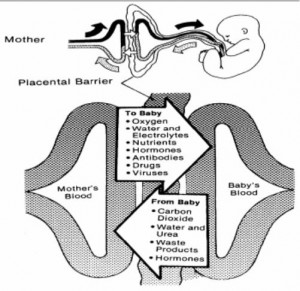Being knowledgeable of the placenta functions gives insight into prenatal life and is helpful in providing nursing care to the unborn and the newborn.
The placenta functions as a transport mechanism between the embryo and the mother (see figure 2-6).
The placenta has many tasks: it transports oxygen, nutrients, and antibodies to the fetus by means of the umbilical vein; removes carbon dioxide and metabolic wastes from the fetus by the two umbilical arteries; serves as a protective barrier against harmful effects of certain drugs and microorganisms; acts as a partial barrier between the mother and fetus to prevent fetal and maternal blood from mixing; and produces hormones essential for maintaining the pregnancy. (The hormones are estrogen, progesterone, and human chorionic gonadotropin (HCG)).

